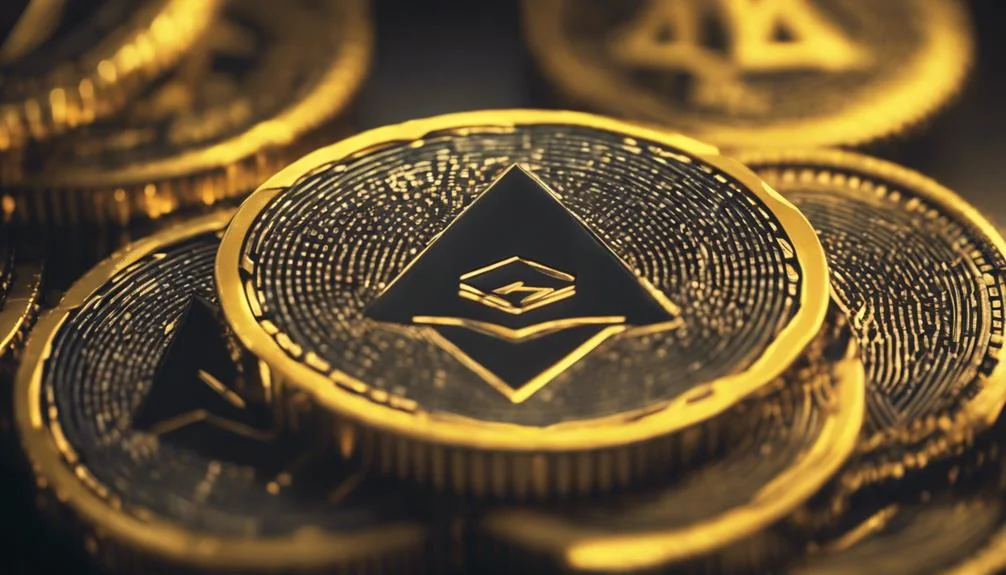When comparing ERC-20 and BEP-20, you’ll see key differences in transaction speed, fees, and ecosystem compatibility. ERC-20 operates on Ethereum, processing transactions in about 15 seconds and incurring higher fees, especially during peak times. In contrast, BEP-20 on Binance Smart Chain confirms transactions within 3 seconds and has considerably lower fees. While both standards support fungible tokens, BEP-20 boasts greater interoperability with BEP-2, enhancing its functionality. Understanding these distinctions is essential for smart investment choices in decentralized finance. To gain further insights into these token standards, you may want to explore their specific use cases and implications.
Table of Contents
Brief Overview of Gain an Edge: ERC 20 vs BEP 20 Token Differences Simplified
- ERC-20 tokens operate on Ethereum, while BEP-20 tokens are based on Binance Smart Chain, offering different ecosystems and functionalities.
- BEP-20 transactions are faster and cheaper, confirming in about 3 seconds with fees around $0.10, compared to ERC-20’s 15 seconds and $5-$50 fees.
- BEP-20 tokens are compatible with BEP-2, enhancing interoperability, whereas ERC-20 tokens primarily function within Ethereum’s ecosystem.
- Both token standards facilitate DeFi applications, with ERC-20 dominating in total value locked, while BEP-20 rapidly grows due to lower costs.
- Understanding the advantages and limitations of each standard is crucial for developers and users when choosing a blockchain for their projects.
Overview of Token Standards
Token standards play an essential role in the blockchain ecosystem, defining the rules for creating and using tokens across different networks. These standards guarantee compatibility and facilitate the development of decentralized applications (dApps). The most notable token standards include ERC-20, which operates on the Ethereum blockchain, and BEP-20, utilized on the Binance Smart Chain (BSC). Both standards provide a framework for creating fungible tokens, allowing developers to manage total supply, balance, and transfer capabilities effectively.
ERC-20, proposed in 2015, has become the most widely adopted standard, playing an important role in Initial Coin Offerings (ICOs) and decentralized finance (DeFi). It supports a variety of dApps, promoting liquidity and enabling a thriving ecosystem. On the other hand, BEP-20 enhances the advantages of ERC-20 by offering faster transaction speeds and lower transaction fees, making it ideal for high-frequency applications.
Understanding these token standards is essential for anyone looking to navigate the blockchain landscape. They not only govern the creation and distribution of tokens but also impact user experience and the overall efficiency of dApps within their respective ecosystems.
Differences Between ERC-20 and BEP-20
While both ERC-20 and BEP-20 serve as important token standards in their respective ecosystems, they differ markedly in key areas such as transaction speed, fees, and interoperability. ERC-20 operates on the Ethereum blockchain, which has a more established ecosystem and a plethora of decentralized finance (DeFi) tools. In contrast, BEP-20 is built on the Binance Smart Chain (BSC), known for its efficiency.
When it comes to transaction speed, BEP-20 transactions can confirm in about 3 seconds, while ERC-20 transactions typically take around 15 seconds. This faster transaction speed can be vital for users looking for quick interactions within DeFi applications. Additionally, gas fees present another significant difference. BEP-20 transactions incur lower fees, usually paid in BNB, whereas ERC-20 transactions often face higher and fluctuating gas fees, paid in ETH.
Interoperability also varies between the two standards. BEP-20 tokens are compatible with both BEP-2 and ERC-20 standards, enhancing their functionality across different blockchain networks. On the other hand, ERC-20 tokens primarily interact within the Ethereum ecosystem, limiting their cross-chain capabilities. These distinctions shape how you engage with each token standard.
Scalability and Transaction Speed

The differences in transaction speed and fees set the stage for a deeper look at scalability. When you’re considering building decentralized applications (dApps), understanding these factors is essential.
| Feature | BEP-20 | ERC-20 |
|---|---|---|
| Transaction Speed | Typically confirms within seconds | Can take several minutes |
| Transactions per Second | Up to 100 | 20-30 |
| Network Fees | Low fees | Higher gas fees |
| Scalability | High scalability | Limited scalability |
Binance Smart Chain (BSC) offers high scalability, allowing for up to 100 transactions per second at low fees, which makes it ideal for fast-growing applications. On the other hand, Ethereum processes only 20-30 transactions per second and faces network congestion, leading to higher fees that can hinder user experience. Although Ethereum 2.0 promises to enhance its capabilities, the current landscape favors BEP-20 for quick and cost-effective transaction processing. As developers weigh their options, these differences in transaction speed and scalability greatly influence their choice between the two token standards.
Security and Interoperability
When considering the security and interoperability of blockchain tokens, both ERC-20 and BEP-20 standards showcase their strengths through robust smart contract functionalities. Security is paramount for these tokens, as smart contracts govern their operations. Regular audits and code reviews are essential to identify vulnerabilities, particularly against threats like reentrancy attacks. ERC-20 tokens thrive within Ethereum’s extensive ecosystem, allowing for broad interoperability across various decentralized exchanges (DEXs) like Uniswap. In contrast, BEP-20 tokens primarily operate within the Binance Smart Chain (BSC) ecosystem, facilitating transactions on DEXs such as PancakeSwap.
Interoperability is further enhanced for BEP-20 tokens, which can seamlessly swap between BEP-2 and BEP-20 standards, fostering flexibility within the Binance ecosystem. Regarding transaction fees and speed, BEP-20 generally offers lower costs and faster transaction times compared to ERC-20, which can greatly improve user experience in high-volume applications. Ultimately, your choice between ERC-20 and BEP-20 might hinge on these factors, as both standards provide unique advantages related to security and interoperability, tailored to different needs within the blockchain space.
Token Creation Process

Creating tokens on either the ERC-20 or BEP-20 standard involves a structured process that guarantees compliance with their respective blockchain ecosystems. For BEP-20 tokens, you’ll typically begin by selecting the Binance Smart Chain platform. Once you’ve set up a wallet, you can deploy your smart contract using development tools like Remix IDE or Binance Chain SDK. In contrast, ERC-20 token creation starts on the Ethereum blockchain, utilizing tools such as OpenZeppelin, Truffle, or Remix IDE to implement essential functions like TotalSupply, BalanceOf, Transfer, TransferFrom, and Approve.
During the token creation process, smart contract development is vital. This includes thorough testing and auditing of your code to identify and mitigate vulnerabilities before launching your token to the public. Both ERC-20 and BEP-20 require this rigorous approach to guarantee adherence to token standards. After successful deployment, your tokens can be listed on exchanges, enhancing their liquidity and accessibility in the market. Ultimately, understanding the token creation process not only helps in creating a successful token but also guarantees its acceptance within the broader blockchain ecosystem.
Exchange Platforms for Tokens
After successfully creating your token, finding the right exchange platform becomes vital for its trading and visibility. For BEP-20 tokens, PancakeSwap is an ideal choice. This decentralized exchange (DEX) operates on the Binance Smart Chain, offering lower transaction fees compared to those associated with ERC-20 tokens on platforms like Uniswap. The reduced gas fees on Binance Smart Chain make trading BEP-20 tokens more cost-effective, which can attract more users to your project.
On the other hand, if you’ve developed ERC-20 tokens, Uniswap stands out as a popular DEX. It allows for seamless trading without intermediaries, providing a user-friendly interface for transactions. Both PancakeSwap and Uniswap exemplify the compatibility of their respective token standards, ensuring that users can easily trade and manage their assets.
When selecting a cryptocurrency exchange, consider the transaction fees, liquidity, and user experience. Whether you’re dealing with BEP-20 or ERC-20 tokens, it’s vital to choose a platform that aligns with your needs. Additionally, you can securely store both token types in wallets like MetaMask, Trust Wallet, or Guarda Wallet, ensuring your assets remain protected while you trade.
Pros and Cons of Each Standard

The choice between ERC-20 and BEP-20 tokens hinges on several key factors, each presenting distinct advantages and drawbacks. ERC-20 tokens excel in their widespread adoption, benefiting from a mature Ethereum ecosystem and robust support across decentralized exchanges (DEXs). However, they often come with higher transaction fees, averaging $5 to $50, especially during network congestion.
Conversely, BEP-20 tokens, operating on Binance Smart Chain (BSC), offer considerably lower transaction fees, typically around $0.10 to $0.50, and faster confirmation times of about 3 seconds. Yet, they may struggle with interoperability outside the Binance ecosystem.
Here’s a quick comparison:
- ERC-20: Stronger security features, thanks to Ethereum’s decentralization and established smart contracts.
- BEP-20: Lower transaction costs and faster processing, appealing to users prioritizing speed and efficiency.
- ERC-20: More extensive resources for token development, which can lead to more innovative applications.
Use Cases in Decentralized Finance
Decentralized finance (DeFi) has transformed how users interact with financial services, and both ERC-20 and BEP-20 tokens play essential roles in this evolution. ERC-20 tokens are widely adopted in DeFi applications on the Ethereum blockchain, enabling functionalities like lending, borrowing, and yield farming. As of October 2023, these tokens account for over $50 billion in total value locked (TVL) across various protocols. On the other hand, BEP-20 tokens operate on the Binance Smart Chain (BSC), providing similar use cases but with lower transaction fees and faster processing times. This has led BSC to surpass $10 billion in TVL by late 2023.
Both token standards are vital for liquidity pools on decentralized exchanges (DEXs); for instance, Uniswap utilizes ERC-20 tokens, while PancakeSwap supports BEP-20 tokens, facilitating seamless token swaps. Additionally, governance tokens, which are often ERC-20 or BEP-20 compliant, empower holders to vote on protocol changes, enhancing user engagement. The interoperability enabled by cross-chain solutions allows you to leverage both ecosystems, increasing overall liquidity and trade volume in the cryptocurrency market. This dynamic interplay showcases the versatility and significance of both token standards in the DeFi landscape.
Future of Token Standards

Looking ahead, the future of token standards like ERC-20 and BEP-20 promises to be dynamic and transformative. You can expect increased interoperability between different blockchain networks, enabling seamless asset transfers and interactions among various token types. Enhanced scalability solutions, like Ethereum’s shift to ETH 2.0, are set to improve transaction speeds and reduce gas fees, potentially bridging the performance gap between ERC-20 and BEP-20.
Key trends to watch include:
- Advanced governance mechanisms that empower users in decentralized finance (DeFi) projects.
- Cross-chain compatibility, allowing tokens to function across multiple platforms.
- Regulatory developments that will shape frameworks ensuring security and transparency.
The rise of layer-2 solutions and sidechains will address scalability issues for ERC-20 tokens, making transactions faster and more cost-effective. As DeFi continues to expand, token standards will evolve to support complex functionalities necessary for this growth. You’ll also find that security measures and compliance will become increasingly important, guiding the future landscape of token standards. This evolution will not only enhance user experience but also foster a more interconnected blockchain ecosystem, paving the way for innovative applications and advancements.
Frequently Asked Questions
Which Is Better, TRC20 or ERC20 or BEP20?
When considering TRC20, ERC20, and BEP20, you’ll find TRC20 advantages in transaction speed and lower fees, which enhance its adoption. However, ERC20 limitations include higher fees and less scalability. BEP20 offers impressive scalability and interoperability, thanks to its connection with Binance. While ERC20 boasts strong liquidity and numerous use cases, TRC20’s innovations and security make it an appealing choice for fast, cost-effective transactions within the growing TRON ecosystem.
What Is the BEP-20 Token Standard?
The BEP-20 token standard, developed for Binance Smart Chain, offers several advantages, including lower transaction fees and compatibility with Binance’s ecosystem. Its use cases range from DeFi applications to governance tokens. However, you might encounter compatibility issues and fewer development tools compared to ERC-20. Security features are robust, yet BEP-20’s adoption rate is still growing. Market trends indicate increasing interest, as users weigh BEP-20 vs. ERC-20 for their projects.
What Is the Difference Between SPL and ERC20?
When you compare SPL and ERC-20, you’ll notice SPL advantages include faster transaction speeds and lower fees, thanks to Solana’s architecture. However, SPL limitations involve its newer ecosystem and less extensive tooling compared to ERC-20. SPL use cases are growing in decentralized finance and NFTs, but compatibility with Ethereum wallets is limited. Security measures are evolving, and as market trends shift, SPL development continues to attract attention within the cryptocurrency landscape.
What Is the Difference Between BRC-20 and ERC-20?
BRC20 tokens operate on the Binance Smart Chain, offering features like faster transaction speeds and lower fees compared to ERC20 tokens. Their advantages include scalability, as they can handle more transactions per second. Use cases are expanding, especially in decentralized finance (DeFi). However, BRC20 faces limitations in adoption and security compared to the more established ERC20. As the market grows, BRC20’s future looks promising, emphasizing interoperability in blockchain ecosystems.
Summarizing
In conclusion, understanding the distinctions between ERC-20 and BEP-20 token standards is essential for traversing the decentralized finance landscape. Each standard has unique features that cater to different use cases, impacting factors like scalability, security, and interoperability. As blockchain technology evolves, these token standards will likely adapt and influence future developments. By analyzing their pros and cons, you can make informed decisions about which standard aligns best with your specific needs in the ever-changing crypto ecosystem.




